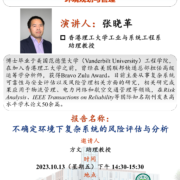Dr. Xiaoge Zhang delivered a talk on “Safety assessment and risk analysis of complex systems under uncertainty” at Nanjing University, China
This talk showcases two different strategies to assess and analyze the safety of air transportation system. In the first place, considering the rich information in the historical aviation accident events, we analyzed the accidents reported in the National Transporation Safety Board (NTSB) over the past two decades, and developed a large-scale Bayesian network to model the causal relationships among a variety of factors contributing to the occurrence of aviation accidents. The construction of Bayesian network greatly facilitates the root cause diagnosis and outcome analysis of aviation accident. Next, we analyze how to leverage deep learning to forecast flight trajectory. Using Bayesian neural network, we fully characterize the effect of exogenous variables on the flight trajectory. The predicted trajectory is then expanded to multiple flights, and used to assess safety based on horizontal and vertical separation distance between two flights, thus enabling real-time monitoring of in-flight safety.
Dr. Xiaoge Zhang delivered a talk on “A Review on Uncertainty Quantification of Neural Network and Its Application for Reliable Detection of Steel Wire Rope Defects” at Hunan University, China
This talk provides a holistic lens on emerging uncertainty quantification (UQ) methods for ML models with a particular focus on neural networks and gives a tutorial-style description of several state-of-the-art UQ methods: Gaussian process regression, Bayesian neural network, neural network ensemble, and deterministic UQ methods focusing on spectral-normalized neural Gaussian process (SNGP). Established upon the mathematical formulations, we subsequently examine the soundness of these UQ methods quantitatively and qualitatively (by a toy regression example) to examine their strengths and shortcomings from different dimensions. Based on the findings of the comparison, we exploit the advantages of SNGP in UQ and develop an uncertainty-aware deep neural network to detect the defects of steel wire rope. Computational experiments and comparisons with state-of-the-art models suggest that the principled uncertainty quantified by SNGP not only substantially enhances the prediction performance, but also provides an essential layer of protection for neural network against out-of-distribution data.
Research paper accepted by Mechanical Systems and Signal Processing
On top of machine learning (ML) models, uncertainty quantification (UQ) functions as an essential layer of safety assurance that could lead to more principled decision making by enabling sound risk assessment and management. The safety and reliability improvement of ML models empowered by UQ has the potential to significantly facilitate the broad adoption of ML solutions in high-stakes decision settings, such as healthcare, manufacturing, and aviation, to name a few. In this tutorial, we aim to provide a holistic lens on emerging UQ methods for ML models with a particular focus on neural networks and the applications of these UQ methods in tackling engineering design as well as prognostics and health management problems. Toward this goal, we start with a comprehensive classification of uncertainty types, sources, and causes pertaining to UQ of ML models. Next, we provide a tutorial-style description of several state-of-the-art UQ methods: Gaussian process regression, Bayesian neural network, neural network ensemble, and deterministic UQ methods focusing on spectral-normalized neural Gaussian process. Established upon the mathematical formulations, we subsequently examine the soundness of these UQ methods quantitatively and qualitatively (by a toy regression example) to examine their strengths and shortcomings from different dimensions. Then, we review quantitative metrics commonly used to assess the quality of predictive uncertainty in classification and regression problems. Afterward, we discuss the increasingly important role of UQ of ML models in solving challenging problems in engineering design and health prognostics. Two case studies with source codes available on GitHub are used to demonstrate these UQ methods and compare their performance in the life prediction of lithium-ion batteries at the early stage (case study 1) and the remaining useful life prediction of turbofan engines (case study 2).




